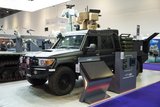Northrop, USMC complete IIE for G/ATOR
Northrop Grumman and the US Marine Corps successfully completed an initial integration event (IIE) in November 2016 for the AN/TPS-80 Ground/Air Task-Oriented Radar (G/ATOR) system, the company announced on 23 February.
The IIE demonstrated G/ATOR's ground weapon locating radar (GWLR) mode's ability to detect and track multiple types of rocket, artillery and mortar (RAM) rounds simultaneously. More than 40 different weapon scenarios were evaluated and over 700 live shots were fired, including a variety of RAM rounds.
GWLR successfully tracked projectiles including volley fire - multiple RAM projectiles intentionally fired in very rapid sequence - between 6km and 50km, demonstrating G/ATOR's long range capability.
Roshan Roeder, vice president, mission solutions, Northrop Grumman, said: 'GWLR mode detects and tracks time-critical incoming threats, calculates an approximate impact point, and then tracks the threat's trajectory back in time to estimate a firing position, allowing counter fire forces to engage rapidly.
'The volley fire capability that G/ATOR demonstrated is critical on the modern battlefield, and all of the data collected during IIE indicates that GWLR can exceed the US Marine Corps' range capability.'
The AN/TPS-80 G/ATOR system is designed for short-range air defence, tactical air operations control, counter-fire target acquisition and future air traffic control. GWLR mode adds software to the G/ATOR system to detect, track and identify RAM projectiles, both 360-degree and sector-only.
Related Equipment in Defence Insight
More from Digital Battlespace
-
![Babcock nears first customer for Nomad AI translation tool]()
Babcock nears first customer for Nomad AI translation tool
Nomad can provide militaries with real-time intelligence, saving critical time on the battlefield.
-
![AUSA 2025: Israel’s Asio Technologies to supply hundreds of improved Taurus tactical systems]()
AUSA 2025: Israel’s Asio Technologies to supply hundreds of improved Taurus tactical systems
Taurus operates alongside the Israel Defense Forces’ Orion system which supports mission management across tens of thousands of manoeuvring forces, from squad leaders to battalion commanders.
-
![AUSA 2025: Kopin pushes micro-LED plans as China moves faster]()
AUSA 2025: Kopin pushes micro-LED plans as China moves faster
The plan for the new displays follows fresh investment in Kopin’s European facilities by Theon and an order for head-up displays in fielded aircraft, with funding from the US Department of Defense.
-
![AUSA 2025: Persistent Systems to complete its largest order by year’s end]()
AUSA 2025: Persistent Systems to complete its largest order by year’s end
Persistent Systems received its largest ever single order for its MPU5 devices and other systems earlier this month and has already delivered the 50 units to the US Army’s 4th Infantry Division.
-
![Aselsan brings in dozens of companies and systems under the Steel Dome umbrella]()
Aselsan brings in dozens of companies and systems under the Steel Dome umbrella
Turkey has joined the family of countries attempting to establish a multilayered air defence system with government approval in August 2024 for the effort landed by Aselsan. Dubbed Steel Dome, the programme joins Israel’s Iron Dome, the US Golden Dome, India’s Mission Sudarshan Chakra and South Korea’s low-altitude missile defence system.
-
![DSEI 2025: MARSS unveils new agnostic multidomain C4 system]()
DSEI 2025: MARSS unveils new agnostic multidomain C4 system
MARSS’ NiDAR system has been deployed using sensors from static platforms to provide detection and protection for static sights, such as critical infrastructure, ports and military bases.




























